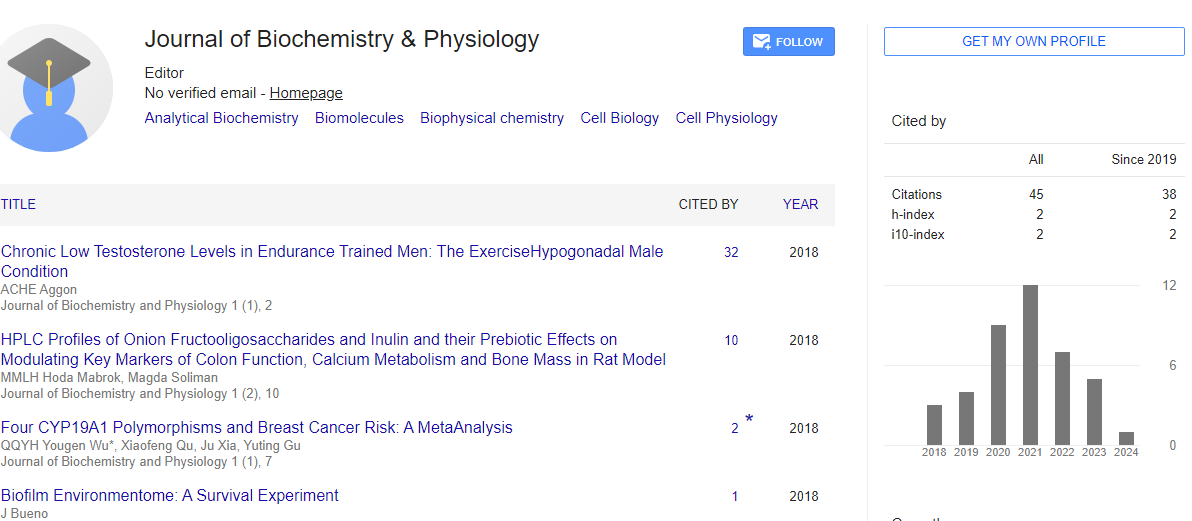Commentary, J Biochem Physiol Vol: 7 Issue: 1
Role of Biomolecules in Cellular Signaling and Communication
Hao Lee*
1Department of Materials Science and Engineering, Beijing Key Laboratory of Environmental Science and Engineering, Beijing, China
*Corresponding Author: Hao Lee,
Department of Materials Science and
Engineering, Beijing Key Laboratory of Environmental Science and Engineering, Beijing, China
E-mail: leeha@o.cn
Received date: 19 February, 2024, Manuscript No. JBPY-24-134957;
Editor assigned date: 21 February, 2024, PreQC No. JBPY-24-134957 (PQ);
Reviewed date: 11 March, 2024, QC No. JBPY-24-134957;
Revised date: 20 March, 2024, Manuscript No. JBPY-24-134957 (R);
Published date: 29 March, 2024, DOI:10.4172/jbpy.1000154.
Citation: Lee H (2024) Role of Biomolecules in Cellular Signaling and Communication. J Biochem Physiol 7:1.
Description
Cellular signaling and communication are fundamental processes that include various physiological functions, including cell growth, differentiation, metabolism, and responses to environmental cues. At the heart of these intricate signaling networks like biomolecules such as proteins, lipids, carbohydrates, and nucleic acids that orchestrate the transmission of signals within and between cells. This study delivers into the diverse roles played by biomolecules in cellular signaling and communication, elucidating their significance in maintaining cellular homeostasis and coordinating complex biological processes.
Proteins are central players in cellular signaling, serving as receptors, enzymes, transcription factors, and structural components of signaling complexes. Receptor proteins, located on the cell surface or within the cytoplasm, recognize extracellular ligands and initiate intracellular signaling cascades upon ligand binding. Enzymes, such as kinases and phosphatases, catalyze post-translational modifications of proteins, regulating their activity and localization. Transcription factors modulate gene expression in response to signaling cues, orchestrating cellular responses to environmental stimuli.
Lipids, once regarded primarily as structural components of cellular membranes, have emerged as critical signaling molecules in cellular communication. Lipid signaling molecules, such as phosphoinositides, eicosanoids, and sphingolipids, regulate diverse cellular processes, including membrane trafficking, cytoskeletal dynamics, and gene expression. Lipid rafts, specialized membrane microdomains enriched in cholesterol and sphingolipids, serve as platforms for the assembly of signaling complexes and the spatial organization of signaling events.
Carbohydrates play key roles in cell-cell recognition and adhesion, facilitating interactions between cells and their extracellular environment. Cell surface carbohydrates, often displayed as glycoproteins or glycolipids, mediate cell adhesion, migration, and tissue organization. Glycosaminoglycans (GAGs), linear polysaccharides found in the extracellular matrix, regulate cell signaling by sequestering growth factors and modulating their interactions with cell surface receptors.
Nucleic acids, primarily DNA and RNA, also participate in cellular signaling and communication. DNA serves as a repository of genetic information, encoding the instructions for protein synthesis and regulating gene expression through epigenetic modifications. RNA molecules, including messenger RNA (mRNA), microRNA (miRNA), and long non-coding RNA (lncRNA), regulate gene expression at the post-transcriptional level, modulating mRNA stability, translation, and degradation.
Cellular signaling networks involve intricate interactions among biomolecules, orchestrating the transmission and integration of signals to elicit specific cellular responses. Crosstalk between signaling pathways enables cells to integrate multiple inputs and fine-tune their responses to diverse stimuli. Dynamic changes in biomolecule localization, post-translational modifications, and protein-protein interactions contribute to the versatility and specificity of signaling networks, allowing cells to adapt to changing environmental conditions.
Dysregulation of cellular signaling pathways underlies various human diseases, including cancer, autoimmune disorders, and metabolic syndromes. Mutations in signaling proteins, aberrant activation of signaling pathways, and alterations in biomolecule metabolism contribute to disease pathogenesis and progression. Targeting key biomolecules and signaling nodes has emerged as a promising strategy for therapeutic intervention, offering opportunities for precision medicine and personalized treatment approaches.
Conclusion
Biomolecules play indispensable roles in cellular signaling and communication, governing the transmission of signals within and between cells. Proteins, lipids, carbohydrates, and nucleic acids act in concert to orchestrate diverse cellular processes, ensuring the maintenance of cellular homeostasis and the coordination of complex biological functions. Understanding the roles of biomolecules in cellular signaling has profound implications for biomedical research and therapeutic development, offering insights into disease mechanisms and novel targets for intervention.
 Spanish
Spanish  Chinese
Chinese  Russian
Russian  German
German  French
French  Japanese
Japanese  Portuguese
Portuguese  Hindi
Hindi 